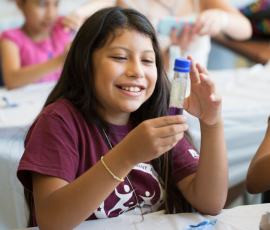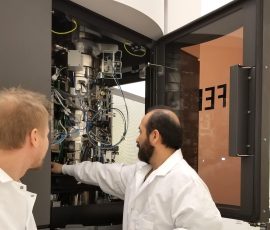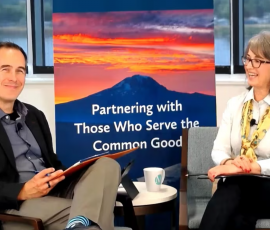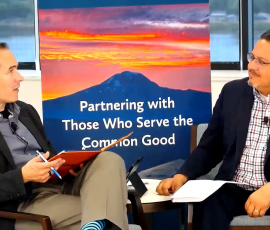
It feels hard to believe that this month marks my official one-year anniversary as CEO of the Murdock Trust. The last 12 months have been filled with joyous opportunities for connection, growth, and investment in new ways to serve the common good. I remain truly grateful to the philanthropic and nonprofit communities of our region and across our country who offered me the warmest of welcomes and with whom I have had the opportunity to collaborate and partner on a wide variety of projects and strategies in service of our mission.
My time has been focused on engaging with and learning from our constituents, partners, and the Murdock team as we seek new ways to enable greater progress toward our mission. I am inspired, grateful, and eager for the work that lies ahead of us to impact the Pacific Northwest for greater human flourishing. As I have shared in some of my prior communications, we are further developing our sectoral approach to better serve present and emerging needs for years to come. Today, I am excited to share some updates on this path forward, as well as a glimpse at what future work is in store.
To best understand the why behind these changes, it is helpful to have a bit of context around the evolution of the work behind the scenes at the Trust and our hopes for the region.
A Region of Promise and Potential
Our benefactor, Jack Murdock, believed strongly that positive impact could come from several areas. He recognized the promise of the nonprofit sector to change lives and shape communities. He realized the value of innovation in bringing new ideas to intractable challenges. The Pacific Northwest as a region is fortunate to be a hub of these principles. A region flush with innovations exemplified in our ecosystem in areas like technology, biomedical, retail, and manufacturing leadership, inspired by a broad array of diverse perspectives and backgrounds.
The Pacific Northwest stands uniquely poised to model the power and impact that can be found through unconventional coalitions, collaboration throughout our communities, and an innovative spirit that seeks solutions for the betterment of all. Considering our near 50 years of dedicated partnership within this region, we recognize the opportunity we have to play a role in facilitating and helping to model the power and impact of sectoral focus and engagement and cross-sectoral collaborations that foster innovative solutions to our most persistent challenges. We humbly seek to be the change we want to see in the world and do unto others in our engagement what we’d hope to have done unto us.
The Growth of the Murdock Trust
Since our founding in 1975, the Murdock Trust’s work has grown and evolved, grounded in the values of our founder, Jack Murdock. Through decades of engagement in the communities we support, we have continued to gain increased understanding regarding existing and emerging needs in the nonprofit sector and the region. Simultaneously, we have been blessed to see our assets grow through a thoughtful investment strategy, expanding the resources we have available to serve those needs of our region.
Our work has grown from a few dozen grants per year administered by under half a dozen staff, including our board of Trustees, to 400-500 grants a year. This happens through a mix of larger strategic projects and smaller initiative-based investments. We offer about a dozen core enrichment training programs that help serve the leadership and development needs of the nonprofit sector. We regularly host convenings and join conversations arranged by community partners to discuss solutions to the larger challenges facing the sectors we serve.
While the Trust has grown to meet the needs of those we serve, we have also kept our focus on being efficient as an organization to maximize our support to the region. A review of benchmarking data shows that our organization has consistently been one of the leanest among our industry peers. We see continuous improvement as critical to meeting both the “promise and potential” of our region.
Why a Sectoral Model?
Over the last several years, growth and change at the Trust have largely been organic and highly responsive. This approach has been an outgrowth of our philosophy to come alongside our grantees and has been necessary to respond to the impacts of Covid-19, unprecedented growth, and broader social issues. During this time, our team stood up critical initiatives and programs all aimed at meeting those present challenges.
As we have looked ahead through our strategic planning process, our vision is focused on being a premier capacity builder, enabling every resource, from grants to programs to convenings to relationships, to build greater capacity in the nonprofit sector and in the region. Our move to a sectoral model helps enable greater service to the sector, continued efficiency in our operations, and preparation for future growth.
This will have the net effect of creating more specialization at the Trust while maintaining our highly collaborative team environment. It will create more specialization between grantmaking and enrichment programs and within the grantmaking team itself. Practically, this means that Trust staff are now moving into teams focusing on one of the sectors we serve. Each team will administer grants, initiatives, programming, and convenings relevant to the organizations and issues present within the given sector.
What is changing? What is staying the same? What is on the horizon?
To be clear, the fundamental types of work are not changing; they are being refined. We will continue to make grants, offer leadership and development programming, and convene leaders to discuss the intractable challenges of our day. Our first step, which we shared a few weeks ago, was to introduce new leadership within the Trust’s team to help guide our work forward. This includes the introduction of the role of Chief Program and Impact Officer, as well as key elevations among existing team leaders. Next month, the Trust will have details regarding the specifics of our new sectors, including our new sector leads and programming staff.
With our sectors, programming staff, and leadership in place, we will then move on to finalizing the third phase of this work: improving our grant application process and system. Our grants management team has been hard at work assessing our current grant application process to identify opportunities to create efficiencies, both for our staff and for our grant applicants.
I am excited to share more updates on this process in the coming months as we continue to strive to be the premier capacity-building grantmaker in the Pacific Northwest. In the meantime, I wish you a joyous summer season!
Romanita Hairston








